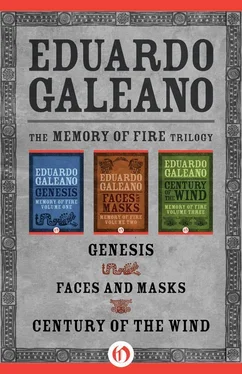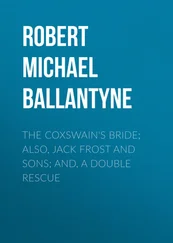Kneeling before the crosses, Motolinía prays: “Forgive them, Lord. I entreat you to forgive them. I know too well that they continue worshiping bloody idols and that if before they had a hundred gods, with you they have a hundred and one. They can’t distinguish the Host from a grain of corn. But if they deserve the punishment of your firm hand, they also deserve the pity of your generous heart.”
Then Motolinía crosses himself, shakes his habit, and starts back down the hill. A little before Ave Maria time, he reaches the monastery. Alone in his cell, he stretches out on his pallet and slowly munches a tortilla.
(60 and 213)
1536: Machu Picchu Manco Inca
Sick of being a king treated like a dog, Manco Inca rises against the men with hairy faces. On the empty throne Pizarro installs Paullo, brother of Manco Inca and of Atahualpa and of Huáscar.
On horseback at the head of a large army, Manco Inca lays siege to Cuzco. Bonfires blaze around the city and arrows of burning tinder fall in a steady rain, but hunger strikes the besiegers harder than the besieged, and Manco Inca’s troops withdraw after half a year amid war cries that split the earth.
The Inca crosses the Urubamba River valley and emerges among the high, fogbound peaks. Stone steps lead him to the secret mountaintop hideaway. Protected by parapets and fortified towers, the fortress of Machu Picchu wields supremacy beyond the world.
(57 and 76)
1536: Valley of Ulúa Gonzalo Guerrero
Victorious, Alonso de Avila’s horsemen withdraw. On the battle-field, among the losers, lies an Indian with a beard. His nude body is an arabesque of ink and blood. Golden symbols hang from his nose, lips, and ears. An arquebus shot has split his forehead.
His name was Gonzalo Guerrero. In his first life he had been a sailor from the port of Palos. His second life began a quarter century ago when he was shipwrecked on the Yucatan coast. Since then he has lived among the Indians. He was a chief in peacetime and a captain in war. He had three children by a Maya woman.
In 1519, Hernán Cortés sent for him.
“No,” said Gonzalo to the messenger, “look at my kids, how pretty they are. Just leave me some of those green beads you’re carrying. I’ll give them to my kids and tell them: ‘My brothers sent you these toys, from my country.’”
Long afterward, Gonzalo Guerrero has fallen defending another country, fighting beside other brothers, the brothers he chose. He is the first conquistador conquered by the Indians.
(62 and 119)
1536: Culiacán Cabeza de Vaca
Eight years have passed since Cabeza de Vaca was shipwrecked on Mal Hado Island. Of the six hundred men who sailed from Andalusia, a few deserted along the way and the sea swallowed many; others died of hunger, cold, or Indians, and four, just four, now reach Culiacán.
Álvar Núñez Cabeza de Vaca, Alonso del Castillo, Andrés Dorantes, and Estebanico, black Arab, have crossed all America on foot from Florida to the shores of the Pacific. Naked, shedding their skin like snakes, they have eaten wild grasses and roots, worms and lizards, and anything they could find alive until the Indians gave them blankets and prickly pears and ears of corn in exchange for their miracles and cures. Cabeza de Vaca has brought more than one dead Indian back to life with his Paternosters and Ave Marias and healed many sick ones making the sign of the cross and blowing on the place where they hurt. From league to league grew the fame of these miracle workers; multitudes came out to greet them on the roads, and villages sent them on their way with dance and song.
In Sinaloa, as they made their way south, appeared the first traces of Christians. Cabeza de Vaca and his companions found buckles, horseshoe nails, hitching posts. They also found fear: abandoned fields, Indians who had fled into the mountains.
“We’re getting warm,” said Cabeza de Vaca. “After such a long walk, we’re close to our people.”
“They aren’t like you,” the Indians said. “You come from where the sun rises and they from where it sets. You heal the sick and they kill the healthy. You go naked and barefoot. You aren’t greedy for anything.”
(39)
1537: Rome The Pope Says They Are Like Us
Pope Paul III stamps his name with the leaden seal, which carries the likenesses of St. Peter and St. Paul, and ties it to the parchment. A new bull issues from the Vatican. It is called Sublimis Deus and reveals that Indians are human beings, endowed with soul and reason.
(103)
1538: Santo Domingo The Mirror
The noonday sun makes the stones smoke and metals flash. Uproar in the port. Galleons have brought heavy artillery from Seville for the Santo Domingo fortress.
The mayor, Fernandez de Oviedo, supervises the transportation of culverins and cannons. Under the lash, blacks haul the cargo at top speed. The carts creak under their load of iron and bronze, and other slaves come and go through the turmoil, throwing buckets of water on the flames that spurt from overheated axles.
Amid the bustle and pandemonium, an Indian girl is searching for her master. Her skin is covered with blisters, each step a triumph as her scanty clothing tortures her skin. Throughout the night and half the day, from one scream to the next, this girl has endured the burns of acid. She herself roasted the guao tree roots and rubbed them between her hands to make a paste, then anointed her whole body, from the roots of her hair to the soles of her feet, because guao burns the skin and removes its color, thus turning Indian and black women into white ladies of Castile.
“Don’t you recognize me, sir?”
Oviedo shoves her away; but the girl insists in her thin voice, sticking to her master like a shadow, as Oviedo runs shouting orders to the foremen.
“Don’t you know who I am?”
The girl falls to the ground and from the ground keeps asking: “Sir, sir, I bet you don’t know who I am?”
(166)
1538: Valley of Bogotà Blackbeard, Redbeard, Whitebeard
A year ago Gonzalo Jiménez de Quesada, black beard, black eyes, went in search of the springs of gold at the source of the Magdalena River. Half the population of Santa Marta went after him.
They crossed swamps and lands that steamed in the sun. When they reached the banks of the river, not one of the thousands of naked Indians who were brought along to carry the guns and bread and salt remained alive. As there were no longer any slaves to hunt down and catch, they threw the dogs into vats of boiling water. Then the horses, too, were cut into bits. The hunger was worse than the crocodiles, snakes, and mosquitos. They ate roots and leather straps. They quarreled over the flesh of any man who fell, before the priest had even finished giving him passage to Paradise.
They continued up the river, stung by rains and with no wind in the sails, until Quesada decided to change course. El Dorado must be on the other side of the mountains, he had concluded, not at the river’s source. So they walked across the mountains.
After much climbing, Quesada now approaches the green valleys of the Chibcha nation. In the presence of seventy scarecrows eaten up with fever, he raises his sword, takes possession, and proclaims that he will never again obey his governor’s orders.
Three and a half years ago, Nicolás de Federmann, red beard, blue eyes, left Coro in search of the earth’s golden center, on a pilgrimage through mountains and plains. His Indians and blacks were the first to die.
When Federmann reaches the peaks where they tangle with the clouds, he sees the verdant valleys of the Chibcha nation. One hundred and seventy soldiers have survived, ghosts dragging themselves along wrapped in deerskins. Federmann kisses his sword, takes possession, and proclaims that he will never again obey his governor’s orders.
Читать дальше












